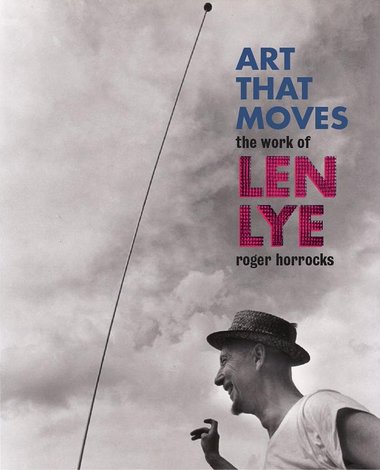John Hurrell – 3 February, 2010
Horrocks’ book is very good, methodically going through the main thematic threads of Lye’s working methods and elaborating on them with great precision.
Roger Horrocks is well known for his fascinating biography of artist Len Lye, and properly much admired for that. This second Lye book he uses to elaborate on some aspects not elucidated earlier for reasons of space. He examines in close detail the concepts behind Lye’s movement-fixated practice, describing in detail his camera-less films and kinetic sculpture and many of their underpinning ideas – much of it centering on the viewer’s body. To do this Horrocks has recapped some of the biographical details around Lye’s production, put them alongside relevant portions of his writing and then often expanded on the various scientific theories that the artist was attracted to, as well as other research that has been developed since his death.
There are five chapters: one on the intellectual tradition Lye is part of that focuses on how we think about movement, another on his amazing life, and others on his distinctive films and sculptures. The third chapter on Lye’s artistic preoccupations overall is particularly rich in ideas, and the highlight of the book. This is because Horrocks is presenting new material that often comes from neurological research and other fields.
In this chapter Horrocks looks closely at Lye’s interest in the notion of bodily empathy: how we can be subconsciously influenced by the movement of objects or people in space we observe around us, like for example swaying trees, or people playing sport or dancing. We can be impelled to involuntarily mimic their movement. This muscular activity Horrocks links to mirror neurons, cells that assist us in acquiring learning skills by copying. Lye wrote about his conscious ability to get inside ‘the shoes of anything that moved, from a grasshopper to a hawk, a fish to a yacht, from a cloud to the shimmering rustle of icy leaves on a brick wall.’ (p.112), so it is interesting to wonder about this type of projection.
Let me digress a little. In a book published for last year’s exhibition of conceptual art The Quick and the Dead that Peter Eleey curated for the Walker Art Centre in Minneapolis, he interviews the cognitive neuroscientist Olaf Blanke about the human sense of bodily location, and outer body experiences such as autoscopy (seeing yourself). In this conversation they discuss works like Magritte’s famous painting La reproduction interdite (1937), and also Bruce Nauman’s video installation Live–taped video corridor (1970) where the viewer sees themselves moving down a long narrow space.
Blanke then talks about an experiment using virtual reality technology where the subjects are stroked on the back with a paintbrush while witnessing it happening to an avatar, a projected image of themselves two metres in front of where they are standing. When asked where they were bodily located they said a foot in front. The visual stimuli overruled the touch stimuli and the usually dominant proprioceptive (intuitive body location) and vestibular (internal balancing) senses.
This experiment seems to tell us about the power of the visual and also (in the case of Lye) the visual imagination: that the body’s sense of self-location is not as fixed as we might have thought – whether viewing itself or (as in Lyelike empathy) seemingly entering something else that moves. And perhaps Lye’s claimed hyper-intense empathy was something like the synaesthesia experienced by Kandinsky and others, a very unusual ability that certain artists possess.
Horrocks’ book is very good, methodically going through the main thematic threads of Lye’s working methods such as the importance of images from the deeply intuitive ‘old brain’, the process of carefully selecting specific patterns of movement, or his refusal to separate brain from body - and elaborating on them with great precision.
In book’s final chapter, Horrocks tells his readers the history and purpose of the organisation that posthumously creates Lye’s work and which promotes it internationally – the Len Lye Foundation. He explains its aims in carrying out a programme of preserving, restoring and constructing Lye works. He even sets out some of the issues raised by Lye Foundation critics – such as the view that a dead artist cannot maintain the same close scrutiny and quality control over their work as when alive, even when that posthumous task is delegated to admirers and close friends. Various key individuals in the work’s production like John Matthews, Evan Webb and Tyler Cann are all introduced, the crucial roles they play carefully explained.
Horrocks is probably the most lucid ‘hardcore’ intellectual New Zealand’s art world has, an unusually outward looking writer with a constant clarity that never indicates any compromise of idea (no matter how complicated). He also has a huge knowledge of many seemingly disparate fields (within the arts and far beyond), accompanied always in his expression by a sense of his own excitement. The Lye biography was very very compact with snappy short chapters, and that resolute focus was part of its appeal. This book in comparison is less so, particularly at its end, for the Foundation chapter could have been a separate smaller publication. Nonetheless the longer more detailed discussions of Lye’s art are an immensely valuable absorbing read, and the interpretative richness of the work is such that Horrocks and his updated research will invariably not have had the last word.

 Advertising in this column
Advertising in this column Two Rooms presents a program of residencies and projects
Two Rooms presents a program of residencies and projects



This Discussion has 0 comments.
Comment
Participate
Register to Participate.
Sign in
Sign in to an existing account.